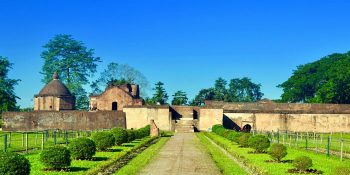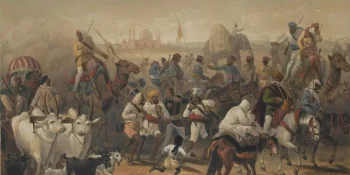The Dwarkadhish Temple, located in the city of Dwarka in Gujarat, India, is one of the most revered Hindu temples dedicated to Lord Krishna. Its history is deeply intertwined with the rich mythology and legends surrounding the life of Lord Krishna. Tracing the historical grandeur of the Dwarka Temple takes us on a journey through ancient scriptures, archaeological findings, and centuries-old traditions.
According to Hindu mythology, Dwarka is believed to be the kingdom established by Lord Krishna himself after leaving Mathura. It is said that Lord Krishna migrated to Dwarka to protect his devotees from the tyranny of his uncle, King Kansa. The ancient texts like the Mahabharata and the Puranas vividly describe the grandeur of Dwarka, its opulent palaces, and the majestic Dwarkadhish Temple, the residence of Lord Krishna.
The Dwarkadhish Temple stands on the banks of the Gomti River and is believed to have been built around 2,500 years ago by Lord Krishna’s great-grandson, King Vajranabha. Over the centuries, the temple has undergone several renovations and expansions, reflecting the architectural styles of different periods.
The architecture of the Dwarkadhish Temple is a blend of Chalukya, Solanki, and Maratha styles, showcasing intricate carvings, elaborate facades, and majestic spires. The temple complex consists of several shrines, mandaps (halls), and courtyards, each dedicated to various deities associated with Lord Krishna.
One of the most sacred spots within the temple complex is the sanctum sanctorum, where the deity of Dwarkadhish, also known as Lord Dwarkadheesh or Lord Krishna, is enshrined. The deity is adorned with elaborate ornaments and is worshipped with great devotion by thousands of pilgrims who visit the temple every year.
The Dwarkadhish Temple has been a center of pilgrimage and devotion for centuries, attracting devotees from all over India and beyond. The temple’s significance is not only religious but also cultural and historical, as it symbolizes the enduring legacy of Lord Krishna and the profound impact of his teachings on Hindu society.
Throughout its history, the Dwarkadhish Temple has faced various challenges, including invasions, natural disasters, and political upheavals. However, it has always stood as a beacon of faith and resilience, inspiring millions of devotees to continue their devotion to Lord Krishna.
In recent times, efforts have been made to preserve and restore the historical significance of the Dwarkadhish Temple. Archaeological surveys and conservation projects have been undertaken to safeguard the temple’s architectural heritage and ensure its longevity for future generations.
Today, the Dwarkadhish Temple continues to be a vibrant center of worship, with daily rituals, ceremonies, and festivals attracting devotees and tourists alike. The temple’s annual festivals, such as Janmashtami (the birth anniversary of Lord Krishna) and Diwali, are celebrated with great fervor and enthusiasm, adding to the temple’s aura of spirituality and devotion.
In conclusion, the history of the Dwarkadhish Temple is a testament to the enduring legacy of Lord Krishna and the timeless appeal of his teachings. From its mythical origins to its present-day prominence, the temple stands as a symbol of faith, devotion, and cultural heritage, inspiring millions to seek solace and spirituality in the divine abode of Lord Krishna.









